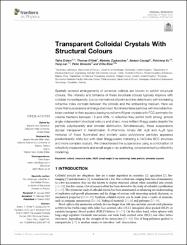| dc.contributor.author | Erdem, Talha | |
| dc.contributor.author | O'Neill, Thomas | |
| dc.contributor.author | Zupkauskas, Mykolas | |
| dc.contributor.author | Caciagli, Alessio | |
| dc.contributor.author | Xu, Peicheng | |
| dc.contributor.author | Lan, Yang | |
| dc.contributor.author | Bosecke, Peter | |
| dc.contributor.author | Eiser, Erika | |
| dc.date.accessioned | 2022-06-30T13:41:32Z | |
| dc.date.available | 2022-06-30T13:41:32Z | |
| dc.date.issued | 2022 | en_US |
| dc.identifier.issn | 2296-424X | |
| dc.identifier.other | WOS:000776772200001 | |
| dc.identifier.uri | https://doi.org/10.3389/fphy.2022.847142 | |
| dc.identifier.uri | https://hdl.handle.net/20.500.12573/1303 | |
| dc.description.abstract | Spatially ordered arrangements of spherical colloids are known to exhibit structural colours. The intensity and brilliance of these structural colours typically improve with colloidal monodispersity, low concentrations of point and line defects and with increasing refractive index contrast between the colloids and the embedding medium. Here we show that suspensions of charge stabilised, fluorinated latex particles with low refractive-index contrast to their aqueous background form Wigner crystals with FCC symmetry for volume fractions between 13 and 40%. In reflection they exhibit both strong, almost angle-independent structural colours and sharp, more brilliant Bragg peaks despite the particle polydispersity and bimodal distribution. Simultaneously, these suspensions appear transparent in transmission. Furthermore, binary AB, A(2)B and A(13)B type mixtures of these fluorinated and similarly sized polystyrene particles appeared predominantly white but with clear Bragg peaks indicating a CsCl-like BCC structure and more complex crystals. We characterised the suspensions using a combination of reflectivity measurements and small-angle x-ray scattering, complemented by reflectivity modelling.
Keywords | en_US |
| dc.description.sponsorship | Funding TE is grateful to the Royal Society for supporting his Newton International Fellowship (NF160409). MZ thanks the Engineering and Physical Science Research Council (EPSRC) and Unilever for the CASE award RG748000. TON acknowledges EPSRC NanoDTC Cambridge EP/L015978/1. AC and EE acknowledge the ETN-COLLDENSE (H2020-MCSA-ITN-2014, Grant No. 642774) and the Winton Program for the Physics of Sustainability. EE was partly supported by the Research Council of Norway through its Centers of Excellence funding scheme, project number 262644. | en_US |
| dc.language.iso | eng | en_US |
| dc.publisher | FRONTIERS MEDIA SAAVENUE DU TRIBUNAL FEDERAL 34, LAUSANNE CH-1015, SWITZERLAND | en_US |
| dc.relation.isversionof | 10.3389/fphy.2022.847142 | en_US |
| dc.rights | info:eu-repo/semantics/openAccess | en_US |
| dc.subject | colloid | en_US |
| dc.subject | structural color | en_US |
| dc.subject | SAXS (small-angle X-ray scattering) | en_US |
| dc.subject | latex particle | en_US |
| dc.subject | photonic crystals | en_US |
| dc.title | Transparent Colloidal Crystals With Structural Colours | en_US |
| dc.type | article | en_US |
| dc.contributor.department | AGÜ, Mühendislik Fakültesi, Elektrik - Elektronik Mühendisliği Bölümü | en_US |
| dc.contributor.authorID | 0000-0002-6231-9717 | en_US |
| dc.contributor.institutionauthor | Erdem, Talha | |
| dc.identifier.volume | 10 | en_US |
| dc.identifier.startpage | 1 | en_US |
| dc.identifier.endpage | 11 | en_US |
| dc.relation.journal | FRONTIERS IN PHYSICS | en_US |
| dc.relation.publicationcategory | Makale - Uluslararası Hakemli Dergi - Kurum Öğretim Elemanı | en_US |


















